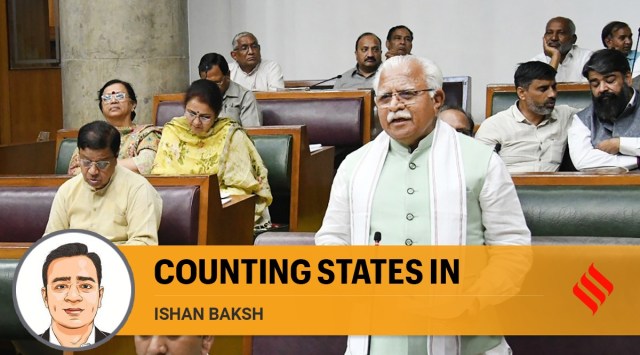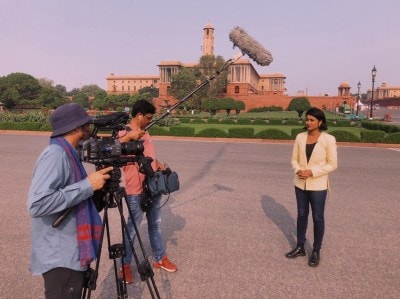- India
- International
What the different state budgets tell us about overall public spending in 2022-23
Ishan Bakshi writes: There are several uncertainties surrounding states’ revenues and expenditures. This makes it hard to assess general government fiscal boost to economy for the coming financial year.
 Haryana CM Manohar Lal Khattar during the state Budget session, in Chandigarh. (PTI Photo)
Haryana CM Manohar Lal Khattar during the state Budget session, in Chandigarh. (PTI Photo)Over the past few weeks, several state governments have presented their budgets for the upcoming financial year. Considering that states, put together, account for a significant share of overall public sector spending in the economy, their expenditure stance is central to a strategy that relies heavily on public spending to revive economic growth.
This article looks at the budgets presented by Bihar, Chhattisgarh, Gujarat, Haryana, Himachal Pradesh, Jharkhand, Karnataka, Kerala, Madhya Pradesh, Rajasthan, Telangana and West Bengal. As this includes states across the development spectrum, it provides some sense of the overall fiscal stance at the state level. Six broad trends emerge.
First, while the Centre has continued on the path of fiscal consolidation — it has projected to bring down its fiscal deficit from 6.9 per cent in 2021-22 to 6.4 per cent in 2022-23 — there does not appear to be a secular trend across states. Nor is there a clear divide across high- and low-income states or states with differing fiscal profiles. For instance, rather than consolidating, Karnataka, Telangana, West Bengal and Madhya Pradesh have budgeted for their fiscal deficits to rise in 2022-23, while Kerala, Chhattisgarh, Jharkhand, and Rajasthan have projected a decline. Some states have continued to cling to fiscal conservatism despite ample space for higher debt-financed spending. Gujarat, for instance, has budgeted for a fiscal deficit of 1.64 per cent in 2022-23, even as its debt-to-GDP ratio stands considerably lower than the all-state average.
In such a scenario, and taking into account the magnitude of past deviations between state budget estimates and the final numbers, it is difficult to arrive at precise estimates of the extent of fiscal consolidation at the general government level in the coming year. (The general government fiscal deficit is pegged to decline from 13.9 per cent of the GDP in 2020-21 to 10.6 per cent in 2021-22.)
Second, state governments have not witnessed a spectacular rise in their revenue receipts in 2021-22, unlike the scenario at the central government level — as per reports, the Centre’s revenue receipts could surpass its revised estimates by a significant margin. Subdued revenue collections at the state level can be traced to two factors. One, it reflects, in part, the nature of the economic recovery. The growing economic concentration among a few big firms has led to higher direct tax collections at the central level. After all, only 1,843 companies accounted for 69 per cent of corporate income tax liability in 2019-20. This skew is now likely to have worsened. On the other hand, state tax revenues, which tend to be largely based on indirect taxes, where such economic concentration doesn’t exist, have fared rather modestly. Two, states have also witnessed a decline in grants from the Centre when compared to their budget estimates. But this is largely because the shortfall in the GST compensation due to the states has been financed through loans.

Third, with the GST compensation cess slated to end in June 2022 in its current avatar, some states have been making the case for continuing with the compensation mechanism in some form to shore up their revenues. However, the numbers suggest that some states have only budgeted for payment of pending dues and for payment of compensation till June 2022. Considering that revenue from the GST compensation cess accounts for a sizeable share of states’ revenues, how this issue is resolved will have a significant bearing on their spending trajectory over the coming years.
Fourth, on the expenditure side, states have historically had a significant share of their total spending tied to meeting their committed priorities. However, as per data from PRS, the share of states’ committed expenditure (salaries, pension and interest payments) in total expenditure is projected to decline modestly, freeing up resources for them to spend on productive areas. In comparison, the Centre’s committed expenditure is expected to rise, largely on account of higher interest payments, limiting its room to manoeuvre.
Fifth, some states have also ramped up their debt repayments during these years. This holds true for both low-income states, such as Rajasthan, Bihar, and Madhya Pradesh, as well as some high-income states, such as Kerala and Haryana. However, as per their medium-term fiscal roadmaps, most states do not expect a sizeable reduction in their debt to GSDP ratios in the coming years. This implies that the burden of reducing the general government debt over the medium term would fall on the Centre.
Sixth, most states have pegged their capital outlays to grow at a faster pace than their revenue expenditure in the coming year. As a consequence, the share of capital outlay in states’ total expenditure is expected to rise. But, considering their track record, it is debatable to what extent these aspirational targets will be met. For instance, as against a budgeted target of Rs 32,774 crore in 2021-22, West Bengal’s capital outlay (excluding loans) has now been pegged at only Rs 19,175 crore. For 2022-23, the state has again budgeted the outlay at Rs 33,144 crore.
However, the annual financial statements accompanying the budgets suggest that some states have so far not factored in the Rs 1 lakh crore interest-free loan announced by the Centre for capital spending. This raises three possibilities. One, it is likely that some states do not want to avail this facility, in which case, overall public sector capital expenditure will not increase to the extent hoped. Two, that states avail this facility during the year, and enhance their capital outlays. Or three, that states avail this facility, but keep capital spending at the budgeted level, and substitute their allocations for capital expenditure in favour of revenue expenditure.
Thus, considering the uncertainties surrounding states’ revenues and expenditures, it is difficult to estimate the general government fiscal impulse to the economy over the coming financial year.
This column first appeared in the print edition on March 31, 2022 under the title ‘Counting stares in’. Write to the author at ishan.bakshi@expressindia.com
EXPRESS OPINION
More Explained
Apr 23: Latest News
- 01
- 02
- 03
- 04
- 05










































